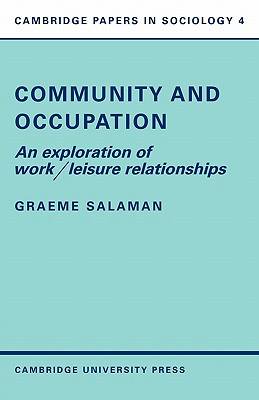
Door een staking bij bpost kan je online bestelling op dit moment iets langer onderweg zijn dan voorzien. Dringend iets nodig? Onze winkels ontvangen jou met open armen!
- Afhalen na 1 uur in een winkel met voorraad
- Gratis thuislevering in België vanaf € 30
- Ruim aanbod met 7 miljoen producten
Door een staking bij bpost kan je online bestelling op dit moment iets langer onderweg zijn dan voorzien. Dringend iets nodig? Onze winkels ontvangen jou met open armen!
- Afhalen na 1 uur in een winkel met voorraad
- Gratis thuislevering in België vanaf € 30
- Ruim aanbod met 7 miljoen producten
Zoeken
Community and Occupation
An Exploration of Work/Leisure Relationships
Graeme Salaman, G Salaman, Salaman
€ 60,95
+ 121 punten
Omschrijving
This book is concerned with the relationship between a man's work and his leisure time, in its broadest sense. At the opposite extreme to the 'instrumental' attitude, where the worker keeps his work and leisure time completely separate, is the close involvement in work and the correspondingly close relationship between working and non-working identities characteristic of 'occupational communities'. This 1974 book attempts to define the concept. After a survey of the theoretical background, Dr. Salaman presents a model of what an occupational community is and the reasons for its existence. The following chapters consist of empirical discussions on some specific examples. There is a detailed comparison between Cambridge railwaymen and architects. Dr Salaman draws the conclusion that occupational communities may be of two sorts - one based on the occupation as a whole, the other on a particular local workplace - and this distinction has considerable implications for the sociology of work.
Specificaties
Betrokkenen
- Auteur(s):
- Uitgeverij:
Inhoud
- Aantal bladzijden:
- 146
- Taal:
- Engels
- Reeks:
- Reeksnummer:
- nr. 4
Eigenschappen
- Productcode (EAN):
- 9780521098526
- Verschijningsdatum:
- 28/06/1974
- Uitvoering:
- Paperback
- Formaat:
- Trade paperback (VS)
- Afmetingen:
- 140 mm x 216 mm
- Gewicht:
- 195 g

Alleen bij Standaard Boekhandel
+ 121 punten op je klantenkaart van Standaard Boekhandel
Beoordelingen
We publiceren alleen reviews die voldoen aan de voorwaarden voor reviews. Bekijk onze voorwaarden voor reviews.











